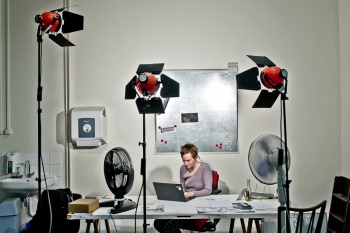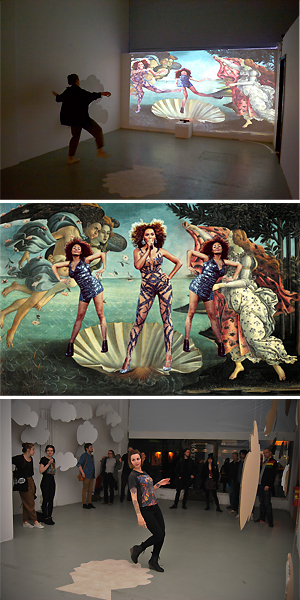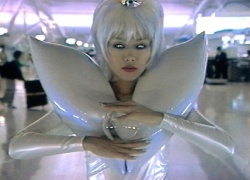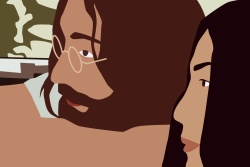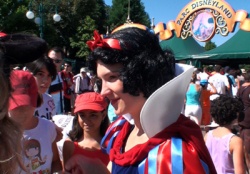User:Dennis van Vreden/proposal1
キュート Cute: The Future of Culture Communication
Abstract and Plan
The work I will be making this year, and have been making last year, will focus on immersive installations that play with the notion of escapism. Be that the way artists escape in their art. Or in the way the viewer, or the person that has the experience of the art, escapes. Taking artists I idolize as examples, as well as people I know who practice music as a profession. In a simple way, I want to make work about "creating realities". New realities that get created by people either to escape actual reality, or realities that are created in order to sell products. Cute capitalism is an example of that. Like the commodification of intimacy and mimicking family relations that is shown in the world of Pokémon.
The possibilities of what I will be making are still very open in terms of the medium I will choose. The work will allow the viewer to escape, as well as give a new sense of awareness, instead of it just being about letting go. The gallery space allowing that, being a space to escape into. I will do practical research on what affect is and what it does by reading the work of Brian Massumi. Through making several experiments like remixing extreme pop music video's and stage performances, shooting my own music video's by working with artists I hope to discover and raise new questions to continue making work on. I took Artist Portraits of people in the studio's at Piet Zwart with lights and windblowers. Relating the artistic process of the performer with the process of sitting behind the computer. From doing that experiment I found out that I wanted to continue putting these lights and windblowers into the workspace, but making it more clear what the person is doing. Since an artist is not very recognizable sitting behind a laptop. What interests me about these is the reality that the person sitting there is creating. Just like in Korean Music video's where artificial landscapes are built in which the music artists perform in. The main reason always seeming to be money (though that is not a part of my motive, the money aspect of it).
The thesis is in a mode of project process research. For the thesis I will be creating a film essay coinciding with a text. Similar to the short video essay I did last year about Modern Escapism (http://tinyurl.com/modernescapism).
Relation to previous practice
Recurring themes in my work have been identity, gender, the body, pop culture and escapism. Each project always begins with a certain fascination for certain behavioural patterns people have.
I have been interested in the stage. The affect of it. The stage gives the opportunity to transform and it is that short transformative moment that fascinates me. The work I did last year is an example of that.
The Wonderful Media Design Technicolor Experience and ビヨンセ! Biyonse are two interactive installations. Both the installations The Wonderful Media Design Technicolor Experience and ビヨンセ! Biyonse had the same setup, but were different in topic. They were set up with a projection and a Kinect underneath it. They also both had music and a center spot facing the projection where the ‘user’ gets in the Kinects radius.
The installations used the Kinect to recognize the users skeletons and movement. The user enters the room not really knowing what will happen. As soon as they approach the center spots laid out in front of the projection the Kinect immediately reads the user and either Beyoncé (ビヨンセ! Biyonse) or Dorothy (TWMDTE) pops up in the screen and reacts to every movement of the user. The techniques that were used in the animation and Kinect were Processing and Animata.
TWMDTE was developed to coincide with the Musical Symposium that took place during the Open Day at the Piet Zwart Institute to represent the Media Design department. Biyonse was a follow up installation to see it in a gallery space and watch the response. There is something quite fascinating to see people react when all of a sudden whatever they do is reinterpreted by technology and acted out into a superstar.
Biyonse turned the gallery into a stage. Creating a center spot was mostly to send the visitor into the radius of the Kinect, but also functioned like the infamous 'Idols' spot where contestants were supposed to show their talents.
Biyonse explicitly invited the visitor to assume over the top poses to make the virtual Beyoncé respond to their movements in unnatural ways. A small movement is of course not of interest, but the Kinect requires some extremity in the skeleton to see a response. TWMDTE version was used in a more extreme way. Since Dorothy and the Wizard of Oz are such classics they were interesting to take to extreme movements that physically aren't possible. To make Dorothy as glitchy as possible. Since the programme I used does not use a 3D model of Dorothy, the moment you turn around for example it remains a flat image and becomes stretched out. Beyoncé being a music artist therefore asks the visitor to actually dance. As if you are choreographing Beyoncé to do your bidding. Fucking her up also happens, but not like the Dorothy version. Of course the music acts as a huge catalyst for dancing. Beyoncé's being very up tempo. Dorothy's being quite slow (with music from the original soundtrack).
When I created these works I found out that I was interested in making immersive works and would like to continue refining it. In both installations it is clear to me that I want to let the viewer/participant to get swallowed up into a world I present them and give a few short experiences. The moment the viewer walks in the radius and forgets everything around them, and the short moment when the viewer rejoins their friends or the crowd is an interesting part of this that I will continue exploiting by making new works.
Another project of mine that is related to what I am doing now is Musicaloke. I created it during the Factory Reset trimester with Florian Cramer. Musicaloke is an interactive virtual product allowing the user to choose a character/celebrity/moviestar they want to become in their own virtual reality.
This product works with the Kinect to recognize the users movement. It’s functions are based on a Karaoke machine. You choose a song and the character you want to become. You take a spot in front of the machine and start moving to the music and basically live your own fantasy life for a minute.
Musicaloke is there to envision your fantasies in a musical way. Creating your own virtual reality as well as experiencing it in reality. It is originally designed as a machine for companies to use during breaks, but was presented in the Factory Reset exhibition as a nomadic kit that encases a laptop and lets you run the program wherever you want.
This project resonates to the photo experiments I did mentioned in the plan. Basically bringing fantasy realities into the workspace and creating a relationship with the perform state of mind to the work state of mind. An awareness of the moment when you start performing or assuming a role.
The Context
In Andy Warhol's Screen Tests I am fascinated by his interest in the personality of the person in front of his camera. It is an extensive research of behavior and mimicry. This corresponds with what fuels my work, which are behavioral patterns.
From watching the documentary Paris is Burning I became extremely interested in the drag queen culture. The documentary is a seven year project by Jennie Livingston and shows the lives of drag queens during the 80s in New York City and the society they created for themselves. It gives a great perspective on subculture. In my work there are often two layers. The extreme and affective layer, often Beyoncé related, and behind that there's the content. I am interested in how this relates to the drag culture. The flamboyant, extravagant outside is often overlooked as funny and superficial, but behind that facade is some very interesting content and emotion.
In 2003 an MTV Diary video was broadcasted starring Beyoncé. This television series is about releasing information about the daily life of artists in a behind the scenes kind of way. Usually involving preparations for events like the MTV Video Music Awards or the Grammy's and behind the scenes footage of music video's.
There was a moment in this episode where Beyoncé first mentioned her alter ego Sasha. This short moment of the mind and body when adrenaline takes over and a transformation takes place. The nerves introduce the moment, and the transformation is activated when the music begins. Then the performing beast takes over.
After only a few more mentions of the Sasha persona, in 2008 the studio album "I Am... Sasha Fierce" was released. Making Sasha into the product it was meant to be. The album makes a two disc divide, a Beyoncé and a Sasha side. Sasha being the extravagant performer side, and Beyoncé being the soft, intimate and personal side, naturally.
Marina Abramovic has a similar feeling when she performs. In a 2009 interview with James Franco she speaks about the lower and higher self. The higher self being the state of mind she has while performing.
I have gotten a large amount of references from my tutorials with Thomson and Craighead including Moriko Mori and Kota Ezawa. Moriko Mori plays a lot with the aesthetic of anime and manga culture and Kota Ezawa makes works that completely flatten and reinvent video footages of famous television moments in a highly stylized pop art way, but keeping the audio. Allowing the viewer to completely reinterpret the content in an almost disturbing way.
The References
Pilvi Takala, The Real Snow White
The absurd logic of the "real character" and the extreme discipline of Disneyland become apparent when a real fan of Disney's Snow White* is banned from entering the park in a Snow White costume. As visitors are encouraged to dress up and a lot of costume-like merchandise is sold at the park, the full costumes are only sold for children. The Disney slogan "Dreams Come True" of course means dreams produced exclusively by Disney.
Anne Allison, The Cultural Politics of Pokémon Capitalism
About the commodification of intimacy through Pokémon.
Marina Abramovic: The Artist Is Present
A documentary about the show in MoMa named The Artist Is Present. The documentary talks about Marina's past works and how they all link to this retrospective exhibition. The film features the process of creating the exhibition until the ending as well as showing an interesting workshop Marina did with the performers who recreated her most historical performances.
Beyoncé
Beyoncé is an American music artist. She rose to fame being the lead singer for the RNB formation named Destiny's Child and started a solo career in 2003.
Paris is Burning
Paris is Burning is a documentary by Jennie Livingston about drag culture in New York City. How they created their own families and have competitions in balls where they dress up to see who can for example portray the most believable executive.
Kota Ezawa
Kota Ezawa is a Japanese-German artist currently based in San Francisco. Ezawa meticulously recreates, frame-by-frame, animated sequences from television, cinema, and art history using basic digital drawing and animation software.
Moriko Mori
Moriko Mori is a Japanese multimedia artist. Works such as Nirvana show her as a goddess, transcending her early roles via technology and image, and abandoning realistic urban scenes for more alien landscapes. She plays with the anime aesthetic.

